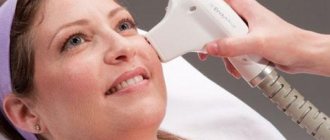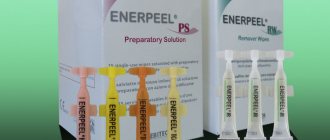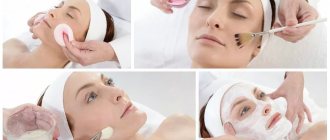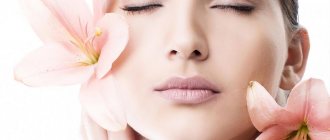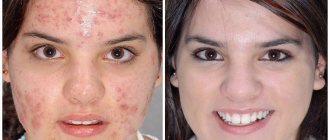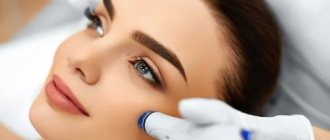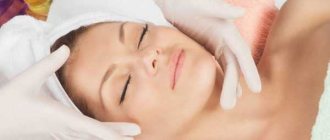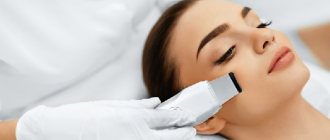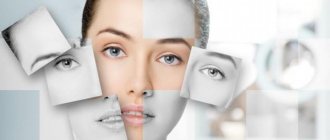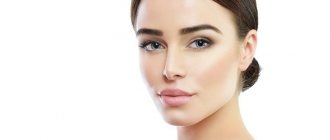What is laser facial resurfacing?
Facial resurfacing using an erbium fractional laser is the most effective method in modern cosmetology for eliminating non-surgical skin defects.
The essence of the procedure is to accelerate the renewal of the epidermis through exposure to laser microbeams, thereby stimulating collagen production. The Palomar erbium laser has a fractional effect on the epidermis. The top layer is not completely damaged, but the formation of microscopic tubules occurs, due to the healing of which the process of active collagen production begins. This allows you to even out the relief of the face, and the skin begins to glow.
Since the Palomar procedure does not involve damage to the top layer of skin, recovery takes only 1-3 days. Skin resurfacing is carried out on any area, from the periorbital area (skin around the eyes) to intimate places.
The effects that the procedure can achieve:
- Improving the oval of the face, neck line
- Removing the rings of Venus
- Elimination of sagging in the delicate area of the upper and lower eyelids
- Normalization of pigmentation
- Restoring elasticity and tone of the skin on the face and body
- Wrinkle correction (reduction of deep wrinkles and complete elimination of superficial ones)
- Treatment of delicate areas around the eyes and mouth (restores smoothness to the skin)
- Elimination of postoperative and post-traumatic scars
- Alignment of skin relief in post-acne condition
- Fighting stretch marks
- Narrowing of enlarged pores
- Rejuvenation and improvement of the quality of the skin of the face, hands, chest, neck, abdomen and other areas
- Elimination of areas of hyperpigmentation
In the professional cosmetology clinic “Idealista,” they perform resurfacing of the face, neck, and décolleté with a modern American-made Palomar Starlux laser. Unlike the Dot CO2 device, this innovative laser has an erbium nature, it works more delicately, does not leave burns and allows you to minimize injuries and avoid complications. The polishing result lasts for several years.
Peeling
Peeling is a method that is used to improve the appearance of the skin on the face, neck or hands. This is a procedure in which a chemical solution is applied to the skin to remove the damaged outer layer of skin, causing it to peel off and eventually flake off. The new skin becomes less wrinkled and smoother. He may be sensitive to the sun for several days, so limited exposure is recommended along with applying a good sunscreen.
Go to prices
Peeling can be effective
- Reduces the appearance of fine lines under the eyes and around the mouth.
- Get rid of facial wrinkles caused by sun exposure and aging.
- Improves the appearance of mild scars.
- Treat certain types of acne.
- Reduces signs of aging, blemishes and other blemishes due to pregnancy or side effect of taking birth control pills.
- Improve skin appearance
Types of peeling
Peels are classified according to their effectiveness depending on the depth of the skin. Depending on the pigmentation and skin problems, superficial, medium and deep peels are used. Typically 6-8 sessions are recommended, which can be repeated at 15-day intervals or as prescribed by your dermatologist.
Cost of the most popular peelings
| Brightening peeling | 3,100 rubles |
| Fruit peeling (summer) | 3,100 rubles |
Superficial or light peeling.
These are peels with alpha hydroxy acids. They penetrate into the surface layer, i.e. into the stratum corneum. They are used to improve the appearance of soft skin, discoloration, and treat acne.
Medium depth peeling.
Medium depth peels penetrate deep into the epidermis and reach the basal layer. This treatment is used to treat age spots, sun damage and mild skin discoloration.
Peeling
Deep peeling.
This peeling penetrates to the dermis. They are used for deep skin rejuvenation and exfoliation of stubborn pigmentation.
Prices for peelings
| Name of procedure | Cost ₽ |
| ABR peeling “Complex” (fruit) | 3 100 |
| Almond surface “Delicate” | 3 100 |
| Glycol surface “Universal” | 3 100 |
| Glycolic "Brightening" | 3500 |
| Glycolic "Exfoliating" | 3 500 |
| Milk “Active moisturizing effect” | 3 100 |
| Pyruvic acid “Treatment of acne and photoaging” | 3 100 |
| Salicylic "High penetration" | 4 100 |
| Salicylic "Penetrating" | 4 500 |
Facial peeling is a procedure for deep cleansing the face, the purpose of which is to exfoliate dead skin cells, smooth the surface of the skin, cleanse the skin of impurities and promote its rejuvenation.
Deep facial cleansers:
- Gommage usually has a creamy texture or is used as a chewable mask. Apply a thin layer to the face or body, and then roll it off with light massage movements as it dries.
- The scrub usually comes in the form of a gel, emulsion or cream. It contains moisturizers and nutrients, as well as fine grains that provide mechanical exfoliation of dead skin cells when rubbed into the skin.
- The exfoliating mask has a gel-like texture that turns into a shrinking scab that rolls off the face, removing dead cells from the surface of the skin.
- The peel also has a gel-like consistency that contains acids, enzymes and other active ingredients that dissolve dead skin cells through a chemical reaction. Types of facial peels Based on depth of penetration: Superficial peeling affects the stratum corneum of the skin without penetrating into the deeper layers. Does not cause inflammation or peeling of the skin. Medium peeling penetrates the skin to the papillary dermis, partially destroying the basement membrane.
- Medium peels are sometimes divided into 2 categories: medium-depth superficial peels (affecting the epidermal layer without affecting the basement membrane) and intermediate peels (partially destroying the basement membrane). Deep peeling penetrates the skin to the reticular dermis, completely destroying the basement membrane.
By technique and method of influence:
- Mechanical peeling (brushing, vacuum peeling, microdermabrasion), based on mechanical action on the skin. Brush peeling can be instrumental or manual. The procedure is carried out with a rotating brush made of natural bristles once a week for oily skin and once every 3-4 weeks for dry skin. Vacuum peeling is carried out using a special device that resembles a “mini-vacuum cleaner”. During the procedure, air is pumped under negative pressure, cleaning pre-opened pores and drawing out impurities. Carry out the procedure once a month. Microcrystalline dermabrasion uses abrasive particles that apply pressure to the skin, exfoliating dead skin cells and polishing the surface of the skin. The procedure is usually carried out once a week. Gas-liquid peeling based on the impact of water and oxygen particles at hypersonic speed (1.8 max.). Can be used for both superficial medium-deep and medium peeling.
- Physical peeling (laser, skin resurfacing, cryopilling, ultrasonic peeling based on physical impact on the skin. With laser peeling and skin resurfacing, the effect is achieved by exposure to directed spectral light energy, which ensures thermal destruction of skin layers. Laser peeling is performed using a CO 2 laser or erbium YAG laser (a combination of both types in one instrument is also possible).
The force of impact during laser peeling usually does not exceed 30 microns, and when resurfacing the skin it is 100-150 microns. Repeated treatment is recommended after 6 months, laser peeling after 1 month.
Laser peeling using a CO 2 laser is a “hot peel” that gives excellent results in removing stretch marks and scars, but has a high risk of skin burns. This method is more often used for laser skin resurfacing.
Laser using an erbium YAG laser is a “cold peeling”, which has a lower risk of complications since it does not provide tissue heating. This method is also very effective. Ultrasonic peeling is often used as part of therapy for combination skin (along with mechanical skin cleansing and warming face masks). Repeated treatment is recommended every 2-3 weeks.
Cryopilling is based on cryotherapy (exposure to low temperatures). The facial skin is treated with dry ice or liquid nitrogen. Ultra-low temperatures promote the formation of fibroblasts, improve the supply of blood and nutrients to skin cells, and also increase skin immunity. The procedure is usually carried out 5-8 times a month.
- Chemical peeling is based on the action of lactic acid, glycolic acid, azelaic acid, phytic acid, lactobionic acid, phenolic acid, etc.), enzymes and biologically active substances (vitamins, minerals, amino acids). AHAs (alpha hydroxy acids) and fruit acids (lactic glycolic almond malic tartaric, etc.) have very small molecules, are water soluble, provide an immediate short-term mild effect and are quickly eliminated from the body. BHAs (beta hydroxy acids) are large molecules with low penetrability, are fat soluble, are harsh on the skin with immediate long-term effects, and take a long time to be eliminated from the body.
In cosmetic procedures, only salicylic acid is used for skin peeling. Enzyme peeling is suitable for all skin types, providing a mild effect, like AHA. Bioactive substances are used to perform retinoic acid peeling (using vitamin A) and peptide peeling (using peptide chains consisting of the remaining parts of α-amino acids).
Depending on skin type:
- Peeling for dry facial skin. For the care of dry skin, peelings with AHA are preferred, as well as peelings with gluconolactone and arginine. Lactic, tartaric and pyruvic acids best moisturize the skin.
- Oily skin with excessive sebum production. Facial peeling.
- For oily skin, peels containing glycolic and salicylic acids, ultrasonic and laser peels, as well as microcrystalline dermabrasion are best suited.
- Peeling for problematic facial skin Almond, glycolic, salicylic, retinoic, pyruvic, azelaic peels, Jessner peel and ABR peel are used to combat acne and remove post-acne. Ultrasonic, vacuum and laser peels, as well as microcrystalline dermabrasion, are also allowed.
- Facial peeling for sensitive skin prone to rosacea. Almond, lactic, azelaic, phytic, lactobionic, retinoic, enzyme and TCA peels are recommended. Mechanical peeling should be avoided.
- Facial peeling for normal skin.
All types of peelings can be used depending on the indications and contraindications in each individual case.
General recommendations:
- Avoid direct sunlight after peeling. Always use sunscreen with SPF 25 or higher. When going outside in sunny weather, wear a shade hat.
- Most peelings should be carried out in autumn or winter, that is, when solar activity is low.
- Avoid tanning and solariums a week before the procedure and during recovery. Or cover your face with a thick towel to avoid sunlight if it cannot be avoided completely.
- Avoid saunas and hot baths during recovery.
- Most peels require you to stop taking certain medications, such as retinoids, hormones, anticoagulants, and medications that cause photosensitivity reactions.
- Preliminary preparation of the skin for peeling is required, as well as proper skin care after the procedure.
- Pay attention to the indications and contraindications for the procedure.
- Pay attention to possible complications that may appear after facial cleansing.
General indications for skin peeling:
- Problematic and acne-prone skin suffering from acne and post-acne, comedones, whiteheads and scars.
- Hyperpigmentation.
- Chrono- and photoaging of the skin.
- Low elasticity and firmness of the skin.
- Hyperkeratosis.
- Dull skin tone.
- Enlarged pores.
- Ptosis.
- Preparation for more serious procedures.
General contraindications to skin peeling:
- Pregnancy and lactation period.
- Diseases associated with colds.
- Acute phase of chronic diseases.
- Acute phase of herpes.
- Infectious skin diseases.
- Skin prone to keloids.
- Violation of skin integrity.
- Cardiovascular diseases.
- Oncological diseases.
- Skin diseases in the acute phase (eczema, allergic dermatitis, atopic dermatitis, psoriasis, etc.).
- Diabetes.
Facial exfoliation effect
- The skin is smooth and soft.
- Increased elasticity and firmness.
- Lifting effect.
- Smooth and healthy skin tone.
- Reduction of wrinkles and scars.
- Reduction or removal of age spots.
- Reduce acne marks.
- Skin rejuvenation.
- Activation of barrier and regenerative functions of the skin.
- Normalization of pH balance and sebum secretion.
Combination with other procedures
Facial peeling shows the best results in combination with other cosmetic procedures such as facial masks, mesotherapy, biorevitalization, manual facial cleansing, non-surgical thread lifting and Botox injections.
Our specialists
|
|
Remember that even a super-effective deep facial peel cannot replace plastic surgery, as it only affects the appearance and complexion of the skin, without affecting deeper tissues such as muscles and fascia. To achieve a significant anti-aging effect, facial peeling should be combined with lifting surgery.
Features of fractional grinding
The Idealist clinic offers innovative fractional facial resurfacing using the Palomar Starlux erbium laser. The essence of the technique is an isolated effect on individual points of the skin, while the surface between these points is not affected. This procedure allows you to work in the most sensitive areas and solve local problems on the face: changes around the eyes, around the mouth, as well as work on the wrists, neck and décolleté and intimate areas.
Depending on the skin problems, the cosmetologist adjusts the depth of laser exposure. This allows you to eliminate defects at different levels: from small wrinkles to scars. The precision of the impact minimizes the risk of complications in the form of re-scarring, so the fractional technique remains one of the most common and safe among all laser resurfacing options.
Pros and cons of the procedure
Laser resurfacing at the Idealista clinic has many advantages compared to alternative cosmetological techniques:
1
Outpatient procedure. There is no need for hospital monitoring after resurfacing.
2
Patients of any age can correct their appearance. Sanding has no restrictions.
3
Rehabilitation is only 1-3 days. When following the cosmetologist's recommendations, the risk of side effects and complications is minimal.
4
The depth of exposure is controlled by the device, which completely eliminates the risk of doctor error.
5
One procedure lasts no more than an hour.
6
The laser is able to affect a small area of the skin without affecting tissues that do not need adjustment. This allows you to specifically eliminate cosmetic problems.
7
The effect of a laser resurfacing course lasts for several years.
Clients leave many positive reviews about laser facial resurfacing, as the procedure gives a visible effect within a few days. The full result is revealed within a month. The modern equipment of the Idealista clinic eliminates the risk of complications during resurfacing, and pain is eliminated using safe anesthesia.
The procedure has few disadvantages:
- Recovery is quick, but with slight swelling in the first 1-3 days. Then moderate peeling is acceptable for a week.
- Formation of scars after a CO2 laser procedure. This is due to failure to follow the cosmetologist’s recommendations. In rare cases, it depends on the individual characteristics of the structure and renewal of the skin. The Palomar erbium laser in our clinic eliminates this risk.
- High cost compared to alternative anti-aging procedures in cosmetology.
The effectiveness of polishing largely depends on the qualifications of the cosmetologist, so contact the Idealista clinic, where experienced specialists with medical education work. Also, the result depends on the device; please note that the equipment at the Idealista clinic has a registration certificate from the Ministry of Health and has been tested for effectiveness and safety.
Advantages over other skin rejuvenation methods
Compared to other methods of rejuvenation, biorevitalization has a number of advantages:
- Very few contraindications;
- The effect lasts for a long time;
- Minimal interference with the natural processes of the body;
- The result is noticeable after the first procedure, even if you need a course;
- Biorevitalization takes place quickly;
- Minimum discomfort during the procedure;
- No special preparation or recovery required;
- Affordable price;
- Renewal and rejuvenation occur at a natural level: the body’s own resources are used.
Preparation for the procedure
Unlike many cosmetic procedures, laser resurfacing requires certain preparation.
After consultation with a cosmetologist, a date for the procedure is set, and the doctor may recommend:
- A month before the procedure, avoid ultraviolet radiation, stay under the sun only with sunscreen, and avoid solariums.
- A week before the session, the face is cleaned in case of inflammation, and a few days before the procedure, a course of antiherpetic drugs is taken.
- Limit exercise and alcohol consumption for several days before your resurfacing.
Following the list of recommendations reduces the risk of complications, shortens the recovery period after the procedure, and increases the effectiveness of resurfacing.
Indications and restrictions
Despite the rave reviews and excellent results that those who have already tried diamond peeling on themselves can boast of, you should not recklessly rush to a beauty salon. This type of mechanical cleaning is not suitable for everyone, and should be abandoned in favor of other measures if the following problems exist:
- - Sunburn.
- — Infectious rashes localized in the area of intended exposure.
- - Pustules on the skin.
- - Cuperosis.
These contraindications for diamond peeling are relative, and after the problem is resolved, you can safely resort to cleaning without fear of unpleasant consequences.
As for indications, peeling will be effective in the following cases:
Contraindications
In some cases, the procedure is unacceptable due to contraindications. The clinic’s doctors individually determine the safety of resurfacing and always conduct examinations to eliminate any risks.
Main contraindications for laser resurfacing:
- Diabetes mellitus of any type
- Pregnancy and breastfeeding period
- Presence of acute infectious skin processes in the procedure area
- Oncology of any location
- Benign neoplasms in the resurfacing area
- Predisposition to the formation of keloid scars
- Exacerbation of herpes infection
- Pathologies of the blood system
In some situations, it is enough to postpone grinding until possible risks are eliminated. In other cases, doctors offer alternative methods of aesthetic skin correction that are acceptable for a particular patient.
Price of the procedure
The price of laser facial resurfacing depends on existing skin defects and the intended area of treatment. The cost is higher than other types of rejuvenation, but according to reviews from cosmetologists, the result is also much more perfect and lasts longer.
The professional cosmetology clinic “Idealista” provides atraumatic fractional laser rejuvenation using innovative equipment from the USA at fair prices. The cost of the service fully corresponds to the result obtained.
What is the difference between an erbium laser and a CO2 laser?
CO2 lasers are the first devices that began to carry out the laser resurfacing procedure. The technology still remains widespread in Russian cosmetology clinics, but is already considered quite outdated. Many clients believe that the aggressive effects of the CO2 laser provide more pronounced results and effective rejuvenation. But such devices increase the risk of complications and are significantly inferior to modern erbium lasers.
The Idealist Clinic uses a modern American-made erbium laser, Palomar Starlux, for laser resurfacing. Thanks to him, the resurfacing procedure is painless, does not cause complications and does not require a long recovery. Laser resurfacing using such a laser does not involve removing the top layer of skin.
Differences between Erbium and CO2 laser
| Erbium laser | CO2 laser |
| The impact of micro-rays on the deep layers of the skin and stimulation of collagen production. | Deep effect on the skin, ablative technology. |
| Painless procedure. | The procedure requires local anesthesia. |
| Short recovery period with slight swelling and moderate redness. | Rehabilitation takes 7-10 days with the formation of unattractive crusts that gradually disappear. |
| There is no risk of scarring as the skin is not damaged. | If the doctor’s recommendations are not followed or the cosmetologist is inexperienced, there is a risk of scar formation. |
The cost of laser resurfacing with an erbium laser is slightly higher than rejuvenation using a CO2 device. But the price is fully justified by the increased comfort and safety for the client, and the high efficiency of the procedure.
Side effects
When using high-quality, certified and safe drugs, side effects occur extremely rarely. In most cases, the procedure goes without complications and does not cause any inconvenience. However, you need to be aware of the possible consequences.
What side effects may occur after the session?
- Discomfort in the injection area.
- The formation of edema - they appear due to the individual characteristics of the body or due to incorrect placement of the needle, but do not affect the result and disappear after a few hours.
- Allergic reaction to the drug - itching, redness, etc.
- Bleeding from the injection site.
- Formation of hematomas - usually this side effect indicates low qualifications of the specialist and incorrect technique for administering the drug.
- Formation of infiltrates - inflammation and suppuration. Virtually impossible if sterility is maintained. Therefore, always pay attention to the conditions in the clinic. And remember, the drug must be opened in front of you.
- Atrophy of skin areas at the site of drug administration is the most severe complication, which is extremely rare.
Patient reviews with before and after photos
The visual result after the procedure is noticeable immediately after the end of rehabilitation. Even if the treatment requires several procedures, changes can be seen after the first one. The effectiveness is demonstrated by patient reviews of facial resurfacing with before and after photos.
“I’ll tell you about my experience of face resurfacing. I am 38 years old and over the past year signs of aging have begun to appear on my face, which are noticeable to others. I work with people, so it is important for me to look impeccable. I decided to undergo laser resurfacing because I heard about the high effectiveness of the procedure. The result exceeded all expectations. The skin after the procedure is smooth, elastic, pleasant not only to look at, but also to the touch. Colleagues compliment me and say that the vacation was good for me, but I know that it’s all laser polishing!”
“I recommend laser facial resurfacing to everyone! No wonder it is recommended to get rid of the consequences of acne. Recovery, of course, is troublesome. Mostly due to the fact that you won’t show yourself on the street in the first 2-3 days. But it's worth it. The price, I think, is quite justified. By the way, many people say that it hurts, but in fact, even without anesthesia cream, the procedure is quite comfortable. The first time after polishing the skin burns a little, but it’s tolerable.”
“Some time ago I had blepharoplasty, which left me with a small scar above my eyelid. It doesn't interfere too much, but is quite noticeable. Therefore, I decided to remove it using laser resurfacing. Despite the sensitivity of the area, I did not feel any particular discomfort. The result is wonderful."
What then?
Despite the fact that diamond peeling, like any other mechanical peeling, does not radically change the appearance and after it you can continue to do your daily activities, you will still have to give up some habits for a short period of time. Thus, a two-week ban is imposed on:
- — Visiting baths and saunas.
- — Tanning (both in a solarium and in direct sunlight).
- — Using cosmetics that contain alcohol and its derivatives.
- — Swimming in open reservoirs and pools.
- — Strenuous physical labor.
- — Apply foundation and blush to the treated areas of the skin.
If you comply with these requirements, the consequences will be as pleasant as possible: the appearance and turgor of the skin will improve, acne marks, scars and age spots will disappear.
